Yesterday on Tangle Refresher 18, new tangler Mir posed the following question:
Howdy! I’m brand new to tangling and am enjoying it already. One question I have has to do with how to choose patterns after you draw a string. Some patterns seem to go better next to each other and others fit better inside certain shapes. Any advice for selecting tangle patterns to use on one tile for a nice balance of weight, texture, contrast, etc? Any tips about how to choose a pattern based on the shape of the space you’re filling? For example, I had a hard time getting a grid pattern inside a teardrop-shaped space and I can’t tell if it’s because a more organic pattern would have been better or if it’s a matter of practice. Thanks!
I thought this was a great question for discussion here today and I’ll start it by offering my two cents.
The main idea behind the Zentangle® method is to remove decision-making and planning — and get you “out of your head” as much as possible. This is the thought behind:
- black and white — no decision-making about color choices
- abstract patterns — so you’re not thinking about drawing “some thing”, but are focused on “one stroke at a time”
- the small tile format — so it can easily be completed in a relatively short time, and
- the border and string providing a defined framework and “the elegance of limits,” as Rick Roberts says.
I suggest selecting a few tangles at random, by any method you want, and then simply use those in whatever sequence your intuition guides you to.
As an example, I used the letters of my name to select tangles to use on the “Tangle your name” post. You can choose words from a dictionary, or any words or names that appeal to you, and use those letters to choose tangles. Just one idea but lots of possibilities.
Some people number the tangles they like and use an online random number generator like random.org to select tangles. If you have the Official Zentangle Kit you can also use the 20-sided die (icosahedron) from that to pick tangles by number.
Here are two great ideas from fellow tanglers for using my TanglePatterns.com TANGLE GUIDE for choosing tangles.
In general you can achieve a pleasing overall effect by using a balance of curvy-line tangles and straight-line tangles.
As far as Mir’s question about fitting grids in certain shaped spaces, I would say it is just a matter of practice. And grids don’t have to be perfect squares. In fact you can get some really interesting effects by what I’ve called “warping” your grid – basically using crisscrossing curved or even wavy lines. Just play with it and have fun. There are no mistakes in Zentangle!
What about you? What advice would you give newbie tanglers like Mir? How do you choose which tangles to use?
|
.oOo. |
|
Enhance your Zentangle experience while supporting TanglePatterns: |
|
CURRENT EDITION! TanglePatterns.com TANGLE GUIDE, 2025 Edition |
|
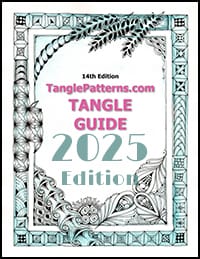 |
The 14th Edition of the TanglePatterns.com TANGLE GUIDE is an instant-download 117-page interactive digital eBook/PDF containing over 2,000 tangles on the site from May 2010 through December 31, 2024. It's a great resource and a must-have digital tool for using the site. Visit the STORE > E-BOOKS page and help keep TanglePatterns.com going by getting your copy now! |
|
"Linda, Thank you! I was relying on too few and getting stuck after 3 years of daily working with Zentangle. This has inspired me to ‘begin again’ with renewed excitement." ~ Barbara R. |
|
| See the BOOK REVIEWS page for more details on its features and view a sample page. Note: this is a digital product you download immediately when you place your order, nothing will be physically mailed to you. | |
| If you're new to Zentangle® and tangling, my TanglePatterns.com BEGINNER'S GUIDE TO ZENTANGLE is just what you need to get started. Also available en Français and en Español. | |
|
|
|
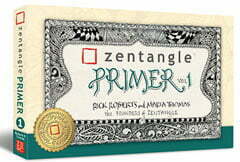 |
This is the only Zentangle book you'll ever need: the fabulous Zentangle PRIMER Vol 1. It's your CZT-in-a-book by the founders of Zentangle®. Visit the STORE tab on the top menu bar or click on the image. For more about the content and to read the rave reviews, visit the BOOK REVIEWS tab. |
| Now available in KINDLE format for $9.99. Spanish Edition here. Japanese Edition here. | |
| "Absolutely the best Zentangle Book yet! As an accomplished artist I used to think I did not need instruction on this art form. How wrong I was! My tangling improved by leaps and bounds after reading this book. If you think you have Zentangle down then you need this book more than ever!" ~ Kris H | |
|
|
|
|
.oOo. |
|

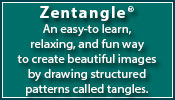


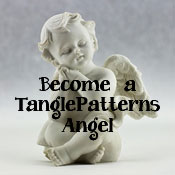


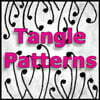
Thanks Mir for asking this question!!! I’ve struggled with this myself! There aren’t any CZT teachers in my area and I have taught myself through books and this wonderful webpage. And thank you Linda for your wonderful answer,this helps alot!!! I just LOVE this website!!!
Teresa~
Ditto Teresa! Love this website!! I’m self taught too and have learned with books and Pinterest. I have found that when I don’t know what pattern to use I take a moment to look at my tangle and kinda feel what should go somewhere. If I have a couple square like patterns kinda close, then I go with something more round; or if my patterns are more full I try to use a more open pattern. You just have to feel it and yes, “get out of your head.” 🙂
I’m a newbie myself; I do have some recent experience to offer though.
I love the unpredictability of just grabbing patterns that appeal to my eye and putting them into the tile formatted with strings. The result is always surprising and appealing. No problem there.
Just this week though I have been tangling a “foot” and “hand”. The hand worked out fantastically, but half-way through the foot I realized that I didn’t like anything about the foot. I discovered that certain patterns just look better in differently-shaped areas. So, I’m re-doing it – same patterns, just placed differently. Hit and miss – or as you say, Linda, practice!
I try to use a mix of straight line and curvy line tangles together. As far as putting grids in irregular shapes – in the beginning I added small post it notes around the shape I was trying to fill and let the gridlines carry over onto the extra paper. When I took those off, I had perfectly fit the grids inside the irregular shape. After a few times of cheating this way, I was able to work without the post it notes.
What a great question. I shall be interested to see what people have to say. I like to alternate dark patterns with light, or sometimes seek out tangles that may lend themselves to the theme of the challenge or tile. It’s fun to use the die as well. It really takes the guess work away so you can just see what tangle comes up and go with it.
How do I select tangles, what a great question! I must admit I have a few favorites that I use a great deal, I also try to use something new each time I do a piece and try it out. I also use the selector die that came with my zentangle kit or I get a feeling as I start to work on something and let the feeling move me to a tangle, in other words am I in the mood for something round, square, uniform or flowing. I like to mix it up. I also get ideas from patterns in nature, in walls or rugs or fabric.
First, a little explanation. I keep small sketchbooks (3.5″x5″), with all the tangles I’ve learned here, six to a page. When I want to draw a new Zentangle, I start by drawing my string, and then I flip thru my “compendium” to choose which tangles I want to use. When I’ve done that, the only other constraint I place on it is to alternate between curvy tangles and more angular ones. That way, I think I get a more p,easing balance. I also try to alternate between tangles which are more bold, alternated with ones which are more delicate. This is another element of balance.
The little notebooks I mentioned at the beginning are a really great reference. So far, I’ve filled two, and started on a third. I can’t tell you how much pleasure I took in creating them, and what a great resource they are. The ones I use are Made by Strathmore.
I know this comment was posted over a year ago, but I just had to respond. I too use a 3.5″x5″ Strathmore sketchbook, and I also do 6 tangles to a page. If there are variations, I usually add them as well.Then I can flip through and see what appeals to me as I start a tangle.
I’ve only been tangling for about 2 months, but I am totally obsessed. All the comments here have been very helpful. My problem is that I am very obsessive/compulsive, and sometimes I’m not happy with the way a tile is going; but I’m learning to just go on to the next tangle and see what happens when it’s all put together. We have a saying in FreeRange knitting (and in some other media as well) “There are no mistakes, only design elements.” I try to let that guide me with my tangles as well.
As a beginner, I also had the same issues. There are so many tangles to choose from! [And thanks to your wonderful site Linda.]
I ended up listing examples in my Evernote ( A free notebook). Then just pick any 2 or 3 tangles and get to work.
I find it more relaxing to focus on just a few tangles.
I use Evernote to store individual tangles and articles related to shading, technique, materials, etc. As I have almost 600 patterns it definitely is a challenge at times to pick just a few. Sometimes I just choose a letter and then pick some of the tangles that start with that letter.
Hi everyone,
a great question indeed. I choose in curved-lined-spaces the grid-form Linda advised, I love to make things turn round a corner or cross a wave.
My choices are:
– mostly I choose for only ‘lines’ shaped tangles or just ‘circles’ or lines and bold tangles as a theme for my whole tile,
– another time I just choose the ones which feels right to use – just which one I like at that moment
– also the ‘name’- or ‘word’-tangle Linda told is a nice one.
One rule for beginners can be</i): round shaped tangles in round shaped spaces and straight shaped (f.i. squares and grids) tangles in straight shaped spaces.
Just try out and experiment doing the tangle. Succes!
Good question! For a while I worked using tangles with names starting with the same letter, starting from A. That was a practice discipline, to make me use other than my favorites. It kept all my pieces from looking the same.
Then I started just carrying tiles and pens with me, and did the easiest to remember, which was, unfortunately, most of my favorites. I have a tangle book which I entered patterns into quite randomly. Currently,I’m trying to use the tangles on one page,or two facing pades, on a tile. When I finish a tile, I turn the page and move my bookmark. Then I go on to the next page next time. I like too alternate straight and circular patterns for variety.
This is a great way to use the reference notebook I have – I flip through it all the time but this way I’d be sure to use some of those lesser known tangles. Thanks for the idea!
I am new to tangling, I’ve only been doing them a matter of a few months, so I must admit to all you more experienced people that I don’t use ‘strings’ and never have. I am using my tangles in conjunction with the letters of our alphabet, so maybe the lines of each letter itself act as a sort of ‘string’. However, it seems to me that ‘strings’ or no strings’, the patterning tends to lead itself and I quite enjoy seeing where they wander on the tile. It can also be interesting if a particular pattern even breaks the boundary of the ‘margins’ set up on the tile and dribbles past slightly!
When choosing which tangles to use, I usually go by ‘texture’ and ‘weight’. For instance a letter with a lot of strokes and spaces can handle patterns with more weight and darkness than say an ‘I’ which could easily be overpowered. However I try not to actively “decide” too much about it all, and just let my mind go and it is soooo nice not to be bound by too many ‘rules’. I LOVE tangling and I thank the ‘fates’ which led me to them !
Sue
I am new to zentangle too and have become addicted. I have taken one class and have spent a huge number of hours following links from blogs and websites. What I have found is that some tangler’s work appeals to me more than others, so I have studied their tangle tiles and practiced their tangles. This way I have a range of tangles in my repertoire that help guide me when I create my own tangles. I am not copying but I am learning from the examples of those whose work I admire.
Although there are no “rights and wrongs’ when doing zentangling, for those of us who are not natural artists or naturally artistic, I think we have to be realistic when looking at the work produced by people with artistic backgrounds and not judge ourselves harshly in comparison. Just as some (most) of us will never be professional ball players, it doesn’t mean we can’t enjoy a game – it just means it is not productive to compare apples and oranges!! I have thought long and hard about this in relation to art quilts – for too long I berated myself for my lack of creativity and skills, thinking that it should be possible to reach the creative heights scaled by those whose work I had seen published in books and magazines. Now that I have become easier on myself, I am enjoying my quilting so much more – and I am applying the same philosophy to zentangle…admire and learn from those with more innate skills but enjoy my own abilities!
Sorry this is so long!
I totally agree with you! I am not going to ever be selling my artwork, as I am not so inclined (artistically or otherwise). But I need to follow a lot of what others have done in order to learn and get my own ideas. It was copying Gustav Klimt’s “The Tree of Life” for a ceramic piece that got me started “doodling”, which is how I found the Zentangling books in the first place! Now I am addicted to tangling, and though still a beginner, I thoroughly enjoy it!
Hi Jakki
I’m new to tangling too and I agree whole heartedly with your comments, I couldn’t have put it better myself. I have been told by tutors in the past that if I’m not satisfied with my results “Don’t beat yourself up, it’s only a piece of paper” or “It’s only a piece of material”. That philosophy has stayed with me and has made crafting much more enjoyable and as you say, most of us can’t compete with the professionals. I just go with the flow, isn’t that what tangling’s about?
Val
Jakki, I could not agree more. I have been through the exact same path of thinking that you expressed.
Hi, In the beginning I was put off by large spaces so drew an extra string or two and that helped a lot. Then I opted for light and dark, straight and curvy, and stretched and squeezed. Then I selected the tangles I was most comfortable with and let loose. Don’t “design” just let it happen. Good luck, and thanks Linda for a wonderful page. Cheers from Oz Peggie Schurch
Love this conversation and can’t add a thing other than to say that when I’m really needing something simple or relaxing, something very “zen”, there’s always the “mono” tangled tile to do, too. I use only one tangle as suggested by Rick and Molly at CZT 7, probably a favorite tangle, and cover the tile with that. I use no string, perhaps just a border can be put down first–or not even that depending on the tangle.)
I think it’s all about the flow. You draw what comes to mind or whatever inspires you at the moment. Don’t think about it, it’s more a feel; like you know what to do next. I try to balance black and white but don’t “think” about it. It’s all about relaxing and enjoying what you’re creating. Just have fun and enjoy,there are no worries when you tangle. It will come to you.
Wonderful ideas everyone! I too am beginning to keep a notebook of tangle patterns. I tend to choose what I am drawn to in the moment when filling my tangles. I love the open airy patterns and those that add depth. There is so much to do and learn and I am so enjoying the process of learning. Thank you Linda for this great site. It’s my favourite.
SO many wonderful ideas here. I am also a fairly new tangler and I too, have grappled with this question. But then all the flow goes out of the tangling. I keep reminding myself that this is for me, I love it, it has become important and fun for me to do and just do it. No contests here.
I have been using various sketch books – Moleskin sketch (good paper) and Quatro’s because they help alot with their own grids. I haven’t done many on the tiles. But I do usually trace the tile on the page. I’ve done lots of experimenting with “space”. Inside a limited tile-size shape, no string in a larger space, letter the individual tangles create the shape. I think that as I begin to learn more and more tangles without referring to the stages, it becomes easier for me to choose without thinking. Mir, thank you for asking this questiona and tanglers thanks for all your comments and advice.
Hi Linda, this is for you with soooo much gratitude for this wonderful site and all the time and effort you devote to keeping it at such a professional and friendly level. I recently received the 2012 guide and think it’s just brilliant. I hope you are aware of how much pleasure, healing and sense of accomplishment you bless us all with.
Thank you,
PaulaDevi
Great to read all these ways of tangling! I have used my book of tangles to refer to, and Lindas recent catalog of patterns is an amazing help for choices, and thanks Linda for compiling it. I am always inspired by the work of others more expert than I am, and studying their work helps push me to do better. I look over a few pieces at a time and then do the pattern that appeals most. I also try to keep a balance of light and dark, detail and simple design. I enjoyed doing the ‘alphabet soup’ ones, using the first letter as the string. Then there was little decision to make which tangles to use!
I love to copy the featured tangle from your posts, Linda, each time I get one emailed to me! I copy them onto 3 x 5 index cards, which I divide into categories like borders, fillers, strings, etc. then when I’m about to begin to tangle, I flip thru my decks and start pulling out whatever appeals at that moment, and this way I can put them next to each other and get a general idea of their effect. Then I let my tangle go crazy! I find I’m much less likely to start over thinking the process and can really get into the ‘zen’ in ‘zentangle’ this way…
Thanks for all you do Linda! In this busy life, your emails remind me to take a moment to tangle every day!
I started putting patterns on shipping tags on a big ring. Need to add more. I guess we all remember our favorites the best and need to branch out with others.
Hmmmmm…. this is a great question! Being both a newbie to Zentangle and a perfectionist due to my background in knotwork, I had a really hard time choosing which patterns to use as well. I’m not quite certain that I’ve found a solution that works every time (I start over alot!) but when I’m really stuck for an idea I have a few things that I do to pull myself out. First, I go through my reference card, cards with patterns on them that I keep on a metal ring, I try to make at least one card each morning to get warmed up. If nothing there feels right I come here and just wander through the patterns. If that doesn’t work, and it often does, I just work on “perfecting” the lines I’ve already drawn… making them smoother, thicker, adding small embellishments, or whatever feels good… this is relaxing and frees me from thinking about the overall piece or what I should do next and opens me up to feel the mood and flow of the tangle which usually suggests the next pattern. And if all else fails… I ask my husband!
Sometimes I don’t think too much about it I just draw a string and start- if the patterns next to ea other aren’t visually separated enough I use shading w the pencil… but other times I deliberately put light patterns next to darker ones or small compact designs next to more open designs…u really can’t make a mistake and I’ve never discarded but added to a tangle w my pen or pencil…its a relaxing learning experience. : )
As far as putting grids in odd shapes, I find they space out better if you make your first grid line across the widest part of your shape. A lot of times when you start at one end of a strange shape the grid lines end up not spacing out elegantly, and get crowded and awkward in the corners.
If you have someone you tangle with, or maybe a friend online that tangles, try making a game or challenge out of choosing tangles. I’ve done this with my mother. We each picked a couple of tangles we had to use in our next zentangle. It’s always fun to see how a collection of the same patterns comes out between different people.
I am realitively new to Zentangles, but quickly have become a great fan. I am still learning patterns and usually use the patterns that I am just learning, but I pull new tangles from this site. The way you have set up tangle patterns.com allows me to choose a letter and just pick a few that appeal to me. Your emails also prompt me to new patterns to build onto.
Great question. I get stumped even after doing these since 2009. I have taught myself through books and great sites like this. Thanks Linda.
I can’t remember patterns very well anymore so I have to flip back through my sketch book to find something I like and will fit into a spot in my string. I like several certain tangles that I use a lot and those are the ones I tend to remember and are easy for me to do. I like to balance the light and darker tangles as well, and circles and grids. I like to balance those different types of tangles so each section doesn’t look like the one next to it. I am not always successful doing that, but I try to do it my best. It is hard for me to just lose myself in a ZIA because of my loss of memory which drives me nuts, so I do tend to look through all my books I bought, tangle sites, and what I have done in the past.
I definitely like to warp the grid using a form to wrap it around or perspective rules (converging lines). A tear drop I would curve all the horizontal lines down and almost parallel and the vertical lines I would start from the point and curve slightly to the bottom.
I have a fun way I like to choose patterns when I am stuck or don’t want to think about how patterns “go” together. I have a “bucket-o-tangles” or so I call it. I have made samples of all tangle patterns and cut them into individual little cards and toss them in a bucket. Then I can grab and pick. My rule is I HAVE to use the one I pick somewhere in/on the string even if I don’t really like it. Sometimes I come to like it by using it. I really liked using the bucket-o-tangles when I was just beginning and unfamiliar with many patterns.
Can I just say – you guys ROCK! What a fabulous community. All of your responses are so helpful. Who knew when I first came across Zentangle (a random pop-up on a website from which I was buying something for my mom)a week later I’d be obsessed AND in the company of such wonderful people? I created my fourth Zentangle card today and I am starting to get a sense of balance: going with the flow, but also directing my efforts to something that makes me giddy that I created it!
Thank you all so much for taking the time to share such thoughtful answers.
I got some big paper and made one inch squres (wound up being a 13×10 grid) and then put small samples of each pattern with name in each square. I then could just close my eyes turn the paper all around and drop my finger to a pattern. Since I didn’t want to fold spindle or mutilate my original I copied the grid so I could fold it up and take it with me. When I added new designs I would make a new copy.
I find if I’m working on a small piece, I’ll wing it. However if I’m working on a larger piece,I look at patterns here at Tanglepatterns or my Zentangle books and try to match patterns to compliment each other. It’s like you wouldn’t wear plaid shorts with a polka dot shirt!
I am new at Zantangle, had a short one hour class at the local library. Do I need to start with a Z all the time or what. I been trying different things and I really enjoy this
I too am new to Tangling, and find I have a very hard time making strings. I would love to see examples of strings to get me started. I don’t know why but that is the hardest part for me!
Hi Katie, have you looked at the TIPS & TOOLS page about STRINGS – there are quite a few ideas there. There are also many more tips on the pages on the top menu bar, so be sure to explore them all and read the comments where the community offers more ideas as well. Welcome and happy tangling!
Thanks for the link, I had missed that page before. Lots of good ideas!
This is a wonderful site and I also really appreciate all of Linda’s work at keeping the site current! …
To any of you who have not yet donated to receive the Pattern Guide, I can’t tell you what a great resource this guide is for tangling on the Go! I refer to the guide often…choosing a tangle from each page to complete my tile. Lots of fun and inspiration!! Get yours today!!
Thanks again for a wonderful site and all of the work that you put into it! Aloha, Andrea
I am pretty much a random selector…except for the Diva’s challenge. One thing I am doing when I have a little time is to zentangle the alphabet…..I draw out a large letter for my string, starting with “A”…then I fill in the areas with tangles starting with that alphabet letter….A is for —–! I am all the way up to “D”!! This is a “filler exercise” for me to practice some of the tangles I have not done, or which I really like…I use this website constantly for resource!!! Thanks, Linda!!
I have been following with interest comments on how to choose what goes together. To me it doesnt really matter. When I am immersed in my tangling and am unsure which patterns to put next to each other, I select areas that do not touch. After this I view my tangle from a distance and then fill-in patterns are much easier. Shading is an important part of the tangle as this can create the push/pull effect in your design.
I found an easy and fun way to choose a pattern if you’re near your computer. We’re all familiar with the pattern examples that run across the top of this page and how they change every 15 seconds or so. Place your cursor on one of the pattern boxes and leave it there…then use the next pattern that pops up under your cursor. Quick and easy!
Linda, thanks for all your hard work, especially the Tangle Guide. I love it!
Thanks Kathy, that’s a very clever idea!! Thanks for sharing it. 🙂
I have tangled all my life.. I didn’t have a name for it. One of my objectives was always never have two of the same touch each other.. line by line, circle by circle, squiggle by squiggle. You get the idea. I have many things that are just line thingies. not names.. Some are similer and liines up to thoes here and some are just off takes of some mentioned. I like the lines thing. I have done that and strings of them down the side of a paper or envelope. Just to find a shape.. and take off what ever it may be. Just ton O’fun and relaxing too. Love it and all the people here wow what creativity… LOVE it.
oops forgot. The tangles on the web sight are amazing. when I am feeling ennergetic I try to copy as many as I can find. I have been using note books the lines are starting to bother me. the back of dollar tree index cards work pretty well and can store in a note book.. just a thought.
I’m very new to Zentangle and the only thing that I can offer is this: I look through the Basics book and choose whatever tangle I feel is appropriate at the time – I’ve only ever done tiles, so far – but sometimes the tangle I’m aiming for isn’t the one that I end up with! This, for me, is what makes it exciting and each tile is different. I’m not suggesting that I’m creating new tangles at all, that’s just the way it works out. I also sometimes find myself just filling in the space with something that ‘just comes to me’.
Brilliant resource, this website.
What wonderful advice you all are giving. I agree there is no “wrong” choice with zentangle. It simply doesn’t matter how you choose your patterns, or what patterns you choose, just start and keep going. You will learn what pleases you and what doesn’t, and when it doesn’t please you all you’ve invested is a little time, some ink and some paper. And you’ve learned even more than you think you have. That is the deep deep wonderful secret of zentangle. It is ALWAYS a positive experience, because there are no expectations. It just happens and suddenly, there before your eyes is a creation unlike anything you or anyone else has ever made or ever will again. One line at a time. Zentangles fill me with DELIGHT. Not much else does, these days, so I treasure my little artworks even more. So will you, I promise. Just let go of thought — zen in — pick of that pen, and dive into another world of your own making.
I love all the comments and ideas. I use this fantastic website just about every day. I have trouble transferring grid tangles into curved and uneven spaces and I’m not sure whether to draw my borders first or my fill-ins. I think I’m thinking too much. I have tangles in a moleskin squared book and look through it when I need a tangle. I also use Linda’s 2012 Tangle Guide. I pick one then look it up on this site to learn how to draw it.
…Or you could just look at the works of other artists for inspiration. Like this guy. He really knows how to tangle…
Absolutely amazing! Thanks for sharing that.
I print out all the patterns I like from here, Rick and Maria’s blog and the ‘Freehand doodle patterns’ Flickr group and keep them all randomly shuffled in a folder. I also have a Moleskine large square notebook (with graph paper) to collect my various drawing-related notes in one place (e.g., shading, crosshatching, stippling, dimension, color wheels) and include other miscellaneous tangles. I always briefly flip through both before I start drawing a piece, so I can select which ones will look ‘right’ depending on what I feel like (…flowy, cubic, B&W or colored, etc. etc.)
I really wanted to keep that zen feeling going and was stuggling with trying to decide which pattern to use.At first I would pick 6-7 patters then draw my string and go from there.I still wanted something more random so I cut a bunch of 2×2 pieces of card stock put one pattern on the front and back, punched a whole in the corner and put them onto one of those metal rings that work like the rings in a 3ring binder.Now I just dropcthe ring and where it opens to is the patterns that I use.
Up until last month, I, too, was a Zentangle virgin. I haven’t taken a Zentangle class yet but I have been a member of The Embroider’s Guild of America and the American Needlepoint Guild where I learned to do “blackwork.” This is done with needle, black [silk] thread, and white or off-white even-weave fabric. Just like Zentangle, it is traditionally done in black and white but as you can see (Google: blackwork embroidery), color works it’s way into the pattern as well. Click on ‘blackwork images’ and you’ll see a wealth of patterns that can be adapted to tangling. Blackwork looks the same on the front and the back of the fabric (at least we don’t have to worry about our backsides when we tangle!). We’ve all been told there are no mistakes in a tangle. However, if someone is having a hard time with a stitch, we’re told to move past it and keep going. If it still looks “off” when you complete your project, THEN go back and work on it. Chances are, you won’t even be able to find it and “civilians” won’t know any different. Love all the sharing..happy tangling to all. S-
I’m fairly new to Zentangle but saw and idea where somebody had made individual tiles of different tangles and store them in a baseball card binder. So I got the idea to make little cards and glue them to playing cards (for sturdiness). Then I store them in the card boxes and just shuffle through them to look for which pattern I want to use.
I came upon this problem myself awhile ago and came up with a cool idea and one that you don’t end up using the same tangle more than once in your design. I took the title of all the tangles (yes it took some time) and wrote them on a piece of paper and dropped them into a box. When I get stuck on what tangle to use I simply reach into the box and grab out a piece of paper and wala my page looked awesome. This has saved alot of brain locks for me while relaxing and tangling. Enjoy and never give up we as tanglers can always come up with something.